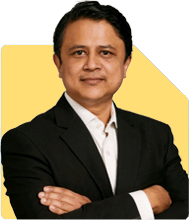Mayank Rautela | Answer |Ask -Follow
HR Expert - Answered on Aug 24, 2022
A management graduate from the Symbiosis Institute of Management Studies with a master's degree in labour laws from Pune University, Rautela has over 20 years of experience in general management, strategic human resources, global mergers and integrations and change management.... more

Dear Mayank,
I have a personal problem that is affecting my work.
Please don’t reveal my name.
My wife and I are facing problems. We start fighting in the morning itself. We live with my parents so they get into it too and everything just escalates because they support me.
I reach office in a bad mood and am impatient with my juniors because of that. In meetings, I sometimes zone out thinking about my problems.
I know it should not affect my work but it is.
My wife and I are trying to work things out.
For personal reasons, we have to live with my parents.
I am thinking of asking for a transfer so that I can live alone for some time but that will mean moving out of the head office and handling lesser responsibilities which I don’t want to do.
I would like to be able to separate my home and work so that I perform effectively in the office.
I really enjoy my job and work in a good company.
How can I get out of this mess and be a good employee?
Thank you.
Hi.
I think you know the solution to your problems.
There’s one tip I can give you -- explore your hobbies or get into sports; this will give you balance and not let unnecessary issues bother you.
I would also like to caution you that if you don’t stop this behaviour at work, your company will initiate necessary action against you and that will impact your career adversely.
So separate personal problems from work and be a good manager and employee.
You may like to see similar questions and answers below
Mayank Rautela | Answer |Ask -Follow
HR Expert - Answered on May 18, 2022
Anu Krishna |1757 Answers |Ask -Follow
Relationships Expert, Mind Coach - Answered on Oct 06, 2020
Kanchan Rai |648 Answers |Ask -Follow
Relationships Expert, Mind Coach - Answered on Sep 08, 2024
Ramalingam Kalirajan |10923 Answers |Ask -Follow
Mutual Funds, Financial Planning Expert - Answered on Dec 22, 2025
Ramalingam Kalirajan |10923 Answers |Ask -Follow
Mutual Funds, Financial Planning Expert - Answered on Dec 22, 2025
Ramalingam Kalirajan |10923 Answers |Ask -Follow
Mutual Funds, Financial Planning Expert - Answered on Dec 22, 2025
Ramalingam Kalirajan |10923 Answers |Ask -Follow
Mutual Funds, Financial Planning Expert - Answered on Dec 22, 2025
Ramalingam Kalirajan |10923 Answers |Ask -Follow
Mutual Funds, Financial Planning Expert - Answered on Dec 22, 2025
Ramalingam Kalirajan |10923 Answers |Ask -Follow
Mutual Funds, Financial Planning Expert - Answered on Dec 22, 2025
Ramalingam Kalirajan |10923 Answers |Ask -Follow
Mutual Funds, Financial Planning Expert - Answered on Dec 22, 2025
Ramalingam Kalirajan |10923 Answers |Ask -Follow
Mutual Funds, Financial Planning Expert - Answered on Dec 22, 2025
Ramalingam Kalirajan |10923 Answers |Ask -Follow
Mutual Funds, Financial Planning Expert - Answered on Dec 22, 2025
Ramalingam Kalirajan |10923 Answers |Ask -Follow
Mutual Funds, Financial Planning Expert - Answered on Dec 22, 2025
























